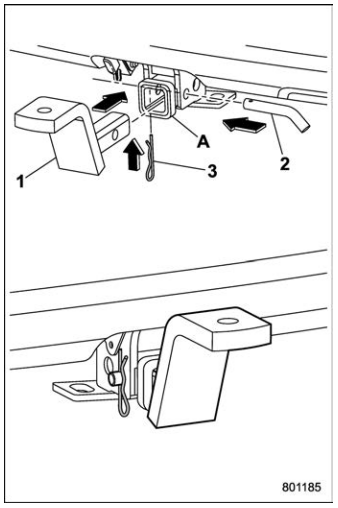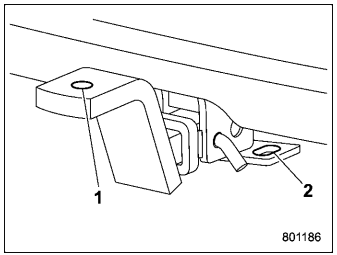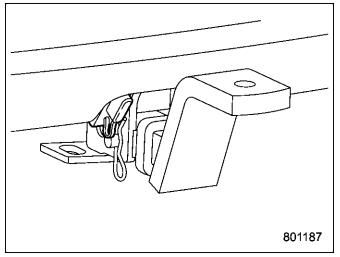Subaru Forester 2019-2025 Owners Manual / Driving tips / Trailer hitch (dealer option) / Connecting a trailer
Subaru Forester: Trailer hitch (dealer option) / Connecting a trailer

- Ball mount
- Hitch pin
- Safety pin
- Hitch receiver tube
- Insert the ball mount into the hitch receiver tube.
- Insert the hitch pin into the hole located on the hitch receiver tube so that the pin passes through the ball mount.
- Insert the safety pin through the provided hole on the hitch pin securely.
- Check the ball mount assembly by
pulling on it to make sure it does not come
off the hitch receiver.

- Hitch ball installation point
- Hooks for safety chains
- Use only a hitch ball that is appropriate for the ball mount and your trailer. The hitch ball must be securely installed on the ball mount.
- Connect your trailer to the hitch ball.
- Connect the trailer and the hitch with
safety chains that will hold the trailer’smaximum gross weight. The chains
should
cross under the trailer tongue to prevent
the tongue from dropping onto the ground
in case it should disconnect from the hitch
ball. Allow sufficient slack in the chains
taking tight turn situations into account;
however, be careful not to let them drag on
the ground.
WARNING
Do not connect safety chains to any part of the vehicle other than the safety chain hooks.

Hitch harness connector
- Connect the hitch electrical wire harness’s black four-pin electrical wire connector to the towing trailer’s wire harness.
- Confirm proper function of the hitch electrical wire harness by individually and combination activating the brake, stop and turn signal lights on the trailer.
NOTE
Always disconnect the trailer electrical wire harness before launching or retrieving a watercraft.
If not towing a trailer
- Remove the ball mount from the hitch receiver tube.
- Place the dust cap over the four-pin connector of the hitch electrical wire harness to protect against possible damage.
- Occasionally lubricate terminals of the four-pin connector using terminal grease.
 Trailer towing
Trailer towing
Your vehicle is designed and intended to
be used primarily as a passenger-carrying
vehicle. Towing a trailer puts additional
loads on your vehicle’s engine, drivetrain,
brakes, tires and suspension and has an
adverse effect on fuel economy...
Other information:
Subaru Forester 2019-2025 Owners Manual: Vacuum pressure system warning
The brake system warning light will illuminate when the vacuum pressure sensor is malfunctioning or brake booster pressure is decreasing. If the brake warning light continues to illuminate for several minutes after starting the engine, there may be a malfunction in the vacuum system...
Subaru Forester 2019-2025 Owners Manual: Average fuel consumption
Displays the driving range per gallon of fuel Displays the driving range per liter of fuel Displays the fuel consumption per 100 km This display shows the average rate of fuel consumption since the trip meter was last reset. TRIP RESET switch Press the TRIP RESET switch to switch between the displays for the average fuel consumption that corresponds to the A trip meter mileage and the average fuel consumption that corresponds to the B trip meter mileage...
Categories
- Manuals Home
- Subaru Forester Owners Manual
- Subaru Forester Service Manual
- Power steering warning light
- Changing a flat tire
- Reverse Automatic Braking (RAB) system ON/OFF setting
- New on site
- Most important about car
Outside temperature indicator
The outside temperature is displayed on the multi-function display (color LCD).
NOTE
The outside temperature indicator shows the temperature around the sensor. However, the temperature may not be indicated correctly or the update may be delayed in the following conditions. While parking or driving at low speeds When the outside temperature changes suddenly (example: when going in and out of an underground parking area or when passing through a tunnel) When starting the engine after being parked for a certain period of time The temperature unit cannot be changed.
Copyright © 2025 www.suforester5.com

